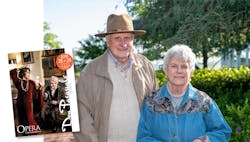2020 Control Process Automation Hall of Fame: Duncan Mellichamp
Read about our other 2020 Inductees:
- Penny Chen
- Ian Nimmo
- Martin Zielinski
From pioneering industrial autonomy to mitigating the risks inherent in large capital projects, the four individuals inducted into the Control Process Automation Hall of Fame this year have all shaped the practice of process automation, and the ripples they’ve already created will long outlast their own careers. All were enthusiastically nominated and confirmed by the current membership—and, I believe, in spirt by those no longer with us, including Charles Cutler who recently left us for more greener, more optimal pastures.
Please join me in welcoming Penny Chen, senior principal technology strategist, Yokogawa; Duncan Mellichamp, professor emeritus, University of California Santa Barbara; Ian Nimmo, owner and principal, User Center Design Services; and Marty Zielinski, technology director (retired), Emerson, to the this esteemed school of very big fish.
Improvise, adapt and overcome
When Duncan A. Mellichamp first arrived in Santa Barbara in 1966, he soaked up more than just the sunshine. The coastal California town had served as support system for a U.S. Marine Corps air station through World War II. It and its many barracks became a new University of California campus, and it seems the Georgia-born chemical engineer had adopted the Marine mantra of “improvise, adapt and overcome” westward, en route to a successful career that spans industry, academia and philanthropy.
“Looking back, I never thought I would take on as many things as I have,” says Mellichamp, now professor emeritus, who notably helped build from scratch the chemical engineering department at the University of California Santa Barbara (UCSB). “You’ve got to be adaptive if you want to succeed,” he says. “Be ready to move when opportunity knocks.”
Those opportunities took him from an off-schedule birth in a farmhouse near Powder Springs, Georgia, without running water or electricity, to a BSChE from Georgia Tech and PhD from Purdue. Co-op work with Dupont Textile Fibers as an undergrad led him to a research engineering position there and groundbreaking work in the area of polyethylene terephthalate precursors. Then, when visiting Purdue to recruit PhD researchers on behalf of Dupont, he was recruited himself. “John Myers, whose teaching assistant I had been at Purdue, asked me ‘Would you like a job teaching process control at a new school?’” Mellichamp says. “I told him no, but he got back to my wife, Suzanne, before I did.”
So began a more than five-decade career mostly with UCSB that, despite his “retirement” in 2003, is still unfolding. Along the way, he’s authored more than 100 research publications on process modeling, large-scale systems analysis and computer control—as well as 1989’s highly regarded Process Dynamics and Control textbook, which he co-authored with three other members of the Process Automation Hall of Fame.
Mellichamp is particularly proud of his post-retirement research focused on estimating profitability and risk in the design of large-scale chemical plants. His latest paper, published only last year, “is really the capstone of everything else I’ve done,” he says. In it, he uses exact, collapsed (“exo-parametric”) modeling methods to reveal a simple and transparent strategy to optimize a design’s key financially-dependent variables.
Mellichamp’s service to UCSB has ranged far beyond the classroom and the research lab. He was elected chair of UCSB’s Academic Senate (1990-92) and of the UC system-wide Academic Senate (1995-97), serving ex officio on the Board of Regents. In 2018 he received the Oliver Johnson award for exemplary service to the UC Academic Senate. He has also led University efforts to protect and expand open spaces near the campus, and to secure space for future University expansion.
He and his wife Suzanne (MA Education ’70 and teacher for nearly 30 years) have also taken an active role in advancing the intellectual vitality of UCSB through their endowment—so far!—of 15 academic chairs in carefully selected domains, or clusters, deemed of increasing importance. “A key feature of universities is that faculty play a major role in peer review and in hiring of colleagues,” Mellichamp explains. “I always felt strongly that it is our responsibility to ensure the people we choose are better than we are. Eventually, our successors will make us all look good.”
Their endowed faculty include primarily younger and mid-career candidates in three clusters. “These Individuals are provided 15 years of extra support to attract them to build a unique program,” Mellichamp explains. “Then the cluster faculty’s extra support is moved to a new area, and to four new people.”
[sidebar id=2]
Since establishing the program in 2003, the cluster areas have successively been systems biology/bioengineering, globalization dynamics, and sustainable (green) chemistry. In 2018, support for the first cluster was rotated out, leaving a successful bioengineering program—and its new building on campus. A new cluster in the area of artificial intelligence took its place. “Over time, we intend that our ideas should help establish many new and dynamic programs in the most important and competitive areas,” Mellichamp says.
“So, just as integral control action works slowly but effectively, pushing process outputs to the desired control objectives,” Mellichamp says, “this combination of bright, highly motivated young faculty in key, new fields will help UCSB achieve its best long-term results.”
About the Author
Keith Larson
Group Publisher
Keith Larson is group publisher responsible for Endeavor Business Media's Industrial Processing group, including Automation World, Chemical Processing, Control, Control Design, Food Processing, Pharma Manufacturing, Plastics Machinery & Manufacturing, Processing and The Journal.

Leaders relevant to this article:


